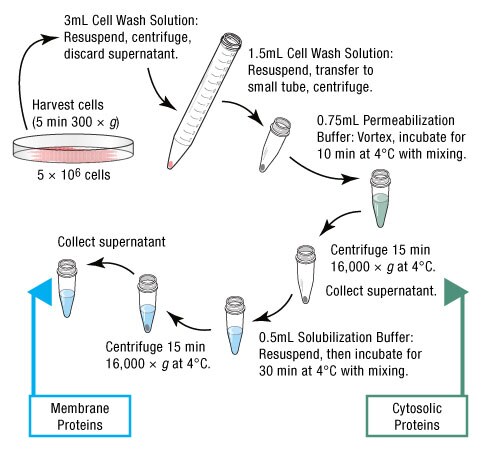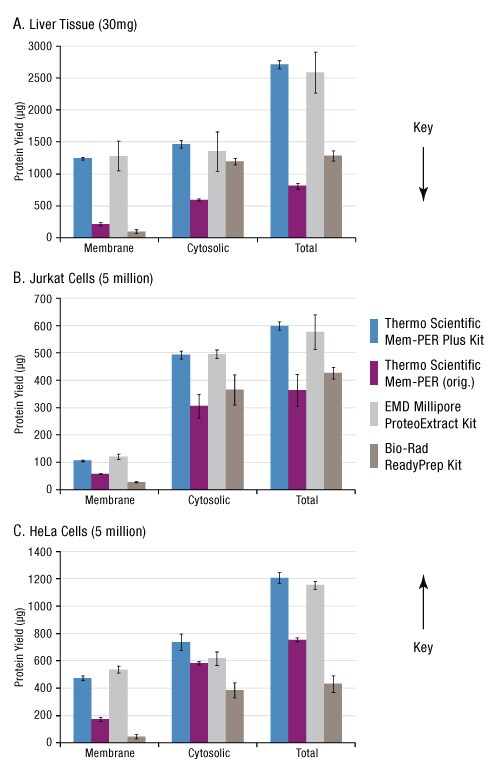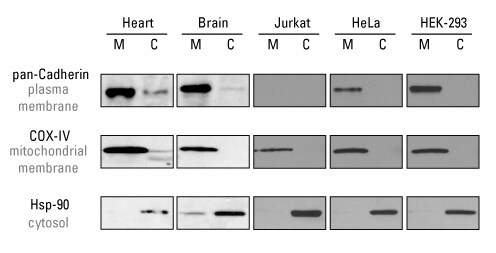Search
哺乳动物细胞膜蛋白提取方法及试剂盒
快速简便地富集细胞膜内蛋白和细胞膜相关蛋白
作者:Evelina Čirbaitė, M.S.1; Scott Meier, M.S.; Juozas Šiurkus, Ph.D.1 - 08/29/13
完整膜蛋白和外周膜蛋白 (MP) 对于维持许多细胞功能非常重要,例如信号转导、细胞完整性、分子溶质的细胞内外转运以及细胞间通讯。完整或外周 MP与膜磷脂双分子层之间的结合物理性质有显著不同。完整 MP 跨越整个磷脂双层,有一个或多个由疏水性残基组成的片段,这些片段与膜磷脂的脂肪酰基相互作用。此外,一些完整 MP 是单拓扑的,仅嵌入双分子层的一个脂质层中。
相比之下,外周 MP 并不跨越磷脂双层。非完整 MP 通常是通过与脂质的极性基团和/或表面跨膜的完整 MP 相互作用,暂时固定在质膜细胞质面的表面,或者可以通过翻译后脂化作用锚定在膜中。
膜蛋白和受体是制药工业研究的最大一类药物靶点。目前可用的治疗分子中约有三分之二以一个或多个膜蛋白为靶点。在可能的情况下,膜蛋白晶体结构有助于阐明它们的功能和发现 MP-药物分子相互作用的机制。然而,尽管 MP 在细胞蛋白质组中含量很高(占所有细胞蛋白的20-30%),迄今为止只有 0.1% 的 MP 晶体结构被确定。
由于缺乏提取方法和试剂,无法从各种细胞类型中获得足够量的 MP,而又不会受到其他蛋白质组分的交叉污染,因此表征 MP 的方法受到了限制。从真核细胞系和组织中提取 MP 的方法有很多,包括亚细胞分离(例如,蔗糖或山梨醇密度超速离心)、阳离子胶体二氧化硅吸附、水相聚合物双相系统、Thermo Scientific Triton X-114 相分离以及高盐或高 pH 缓冲液。这些传统方法大多费时费力,并且需要昂贵的超速离心设备。
Thermo Scientific Mem-PER Plus 细胞膜蛋白提取试剂盒采用简单的试剂步骤和台式微量离心机,可小规模溶解和富集培养细胞和组织中的完整蛋白和膜相关蛋白(图 1)。Mem-PER Plus 试剂盒(货号 89842)取代了我们之前的 Mem-PER 试剂盒,后者基于 Triton X-114 相分离。在本文中,我们将提供数据来展示较新的 Mem-PER Plus 试剂盒的性能。

图 1.使用 Mem-PER Plus 膜蛋白提取试剂盒从哺乳动物细胞中提取膜蛋白的工作流程示意图。首先,用含有渗透稳定缓冲液的温和去垢剂对细胞进行渗透稳定,目的是释放可溶性的细胞膜蛋白。在去除含有亲水蛋白的可溶性成分后,使用膜增溶缓冲液从不溶性成分中提取膜蛋白。所需总时间: ≤90 分钟。
使用早期的 Mem-PER 膜蛋白提取试剂盒进行提取时,会得到含有 MP 的粘性洗涤剂基疏水成分,这需要在进行下游流程(如蛋白质浓度测定、SDS-PAGE 和免疫印迹)之前进行进一步处理。新开发的 Mem-PER Plus 膜蛋白提取试剂盒的流程无需相分离步骤,因此,MP 的提取更简单、高度可重复,并且与下游应用兼容。此外,新的 Mem-PER Plus 试剂盒适用于提取温度敏感的 MP,整个提取过程在 4°C 下进行。
我们使用各种市售细胞膜蛋白提取试剂盒评估了从多种哺乳动物细胞系和几种小鼠组织中提取膜蛋白的效率:Thermo Scientific Mem-PER Plus 膜蛋白提取试剂盒、Thermo Scientific Mem-PER 真核膜蛋白提取试剂盒(第一代试剂盒)、EMD Millipore ProteoExtract 天然膜蛋白提取试剂盒 (Merck),以及 Bio-Rad ReadyPrep 蛋白提取试剂盒膜 I (Bio-Rad)。我们使用这些试剂盒从组织样本和两种培养细胞系中提取膜蛋白(详见方法部分)。我们比较了所得的细胞质和膜蛋白组分的总产量(图 2)。

细胞质和膜蛋白组分的蛋白定量表明,使用 Thermo Scientific Mem-PER Plus 试剂盒获得的 MP 产量最高(图 2)。与 ProteoExtract 天然膜蛋白提取试剂盒获得的产量相当。
细胞膜和细胞质蛋白组分的纯度(低交叉污染)与产量同样重要。为了验证 Mem-PER Plus 细胞膜蛋白提取试剂盒获得的高产量是否也是高质量的膜蛋白提取,我们对来自细胞和组织样本的膜和细胞质组分进行了免疫印迹分析(图 3)。对常见膜蛋白标记物的检测显示,膜蛋白 COX-IV 和 pan-Cadherin 在细胞膜成分中高度富集,而在细胞质成分中的交叉污染非常低。(Jurkat 细胞无粘附性且不表达钙粘素,因此在该细胞膜成分中未检测到钙粘素。)此外,从组织或细胞提取的膜蛋白成分中检测到的细胞质蛋白 Hsp90不到 10%。

图 3.从组织和细胞系中高效富集膜蛋白。使用 Mem-PER Plus 膜蛋白提取试剂盒从 30 mg 组织(小鼠大脑和心脏)或 5 x 10^6 培养细胞(Jurkat、HeLa 或 HEK-293 细胞系)中分离膜蛋白。通过 SDS-PAGE 分离膜和细胞质组分 (10 mg),转移到硝酸纤维素膜上,并通过化学发光免疫印迹法对 pan-Cadherin、COX-IV 和 Hsp90进行评估。(组织印迹使用 myECL Imager 成像;培养细胞印迹通过曝光 X 光胶片成像。)
提取具有多个跨膜结构域的 MP 的效率也是 MP 提取方案的一个重要关注点。为了评估 Mem-PER Plus 试剂盒在这方面的表现,我们使用 Mem-PER Plus 膜蛋白提取试剂盒对多个细胞系的提取物进行了免疫印迹分析(图 4)。该试剂盒能有效提取从 1 个膜内结构域 (Caveolin-1) 到 10 个跨膜结构域(Na+/K+ATPase alpha 亚基)的膜蛋白。HepG2 和 LnCAP 细胞不表达内源性 caveolin。蛋白酶激活受体-2 (PAR-2) 是一种 G-蛋白偶联受体,仅在 HepG2 细胞的膜组分中检测到。这些结果表明,提取效率取决于特定 MP 的表达水平和特定细胞中膜微环境(例如富含胆固醇的脂筏)的流动性。

图 4.高效提取各种细胞系中的多种跨膜蛋白。按照 Mem-PER Plus 细胞膜蛋白提取试剂盒操作流程,从 5 x 10^6 个培养细胞中分离膜蛋白。通过 SDS-PAGE 分离膜组分 (30 mg),转移到硝酸纤维素膜上,并用使用相应蛋白的抗体和 HRP 标记的二抗进行探测。使用 Super Signal West Dura 底物显影印迹,并在 myECL 成像仪中曝光 1 分钟。
新型 Thermo Scientific Mem-PER Plus 细胞膜蛋白提取试剂盒专为从培养的哺乳动物细胞或组织中富集完整蛋白和膜相关蛋白而开发。MP 的分离基于温和去垢剂选择性提取方案。与第一代 Mem-PER 试剂盒方案相比,新方案更易于执行,并且可最大程度地减少细胞膜蛋白污染。使用 Mem-PER Plus 试剂盒提取后,分离的膜蛋白组分可直接用于许多下游应用,包括蛋白估算、SDS-PAGE 和免疫印迹。
细胞膜蛋白提取
使用以下产品分离膜蛋白,每种产品均按照其各自的方案进行:
- Thermo Scientific Mem-PER Plus 膜蛋白提取试剂盒(货号 89842)
- Thermo Scientific Mem-PER 真核膜蛋白提取试剂盒(货号 89826)
- EMD Millipore ProteoExtract™ 天然膜蛋白提取试剂盒(货号 444810,Merck)
- Bio-Rad ReadyPrep 蛋白提取试剂盒(膜 I)(货号 163-2088,Bio-Rad)
Thermo Scientific Mem-PER Plus 膜蛋白提取试剂盒(货号 89842)方案:
- 小鼠组织: 切除小鼠组织(心脏、大脑、肝脏),称重并在磷酸盐缓冲盐水 (PBS) 中冲洗。其余步骤按照 Mem-PER Plus 软组织膜蛋白提取试剂盒(货号 89842)的说明进行。首先在细胞洗液中清洗组织,然后使用剪刀和 Dounce 组织研磨机在渗透稳定缓冲液中将组织匀浆。将匀浆转移到新的 2 mL 管中,并在 4°C 下孵育 10 分钟,持续混合。在 4°C 下以 16,000 x g 离心 15 分钟,分离细胞膜蛋白。将沉淀重悬于增溶缓冲液中,并在 4°C 下孵育 30 分钟,持续混合。在 4°C 下以 16,000 x g 离心 15 分钟,回收膜和膜相关蛋白。
- 哺乳动物细胞: 使用细胞刮刀收获粘附的哺乳动物细胞,并将约 5 x 10^6 个细胞重新悬浮在生长培养基中。其余贴壁和悬浮细胞系步骤均按照 Mem-PER Plus 贴壁/悬浮哺乳动物细胞膜蛋白提取试剂盒(货号 89842)的说明进行。将收获的细胞悬浮液(约 5 x 10^6 个细胞)以 300 x g 的速度离心 5 分钟。用细胞洗液清洗细胞团块两次,然后以 300 x g 的速度离心 5 分钟。将细胞重悬在渗透稳定缓冲液中,并在 4°C 下孵育 10 分钟,持续混合。细胞溶质蛋白在 4°C 下以 16,000 x g 的速度离心 15 分钟,分离细胞膜蛋白。将沉淀重悬在增溶缓冲液中,并在 4°C 下孵育 30 分钟,持续混合。在 4°C 下以 16,000 x g 的速度离心 15 分钟,回收膜和膜相关蛋白。
蛋白浓度的测定
根据微孔板操作流程,使用 Pierce BCA 蛋白测定试剂盒(货号 23225)和牛血清白蛋白标准品(货号 23208)测定蛋白浓度和产量。除了 Mem-PER 试剂盒(货号 89826)和 Bio-Rad ReadyPrep™ 试剂盒(货号 163-2088,Bio-Rad)中的膜蛋白组分首先在透析缓冲液(25mM HEPES、10mM NaCl、0.5% CHAPS)中4°C 透析过夜外,所有蛋白样品均在提取后直接进行评估。
免疫印迹分析
在变性的 4-20% Tris-甘氨酸 SDS-聚丙烯酰胺凝胶上分离等量(基于蛋白测定)的总蛋白(10 µg 或 30 µg),然后转移到硝酸纤维素膜上。在含Tween™ 20的Tris 缓冲盐水中加入5% BSA ,封闭 1 小时。然后在室温下用 1:1000 稀释的相应一抗检测1 小时,再用 1:20,000 稀释的相应辣根过氧化物酶 (HRP) 偶联二抗(货号 31430)或(货号 31460)检测。使用 Thermo Scientific SuperSignal West Pico 化学发光底物(货号 34080)检测条带。图像使用 Thermo Scientific myECL Imager(货号 62236)或 X 射线胶片生成。
一抗
使用了以下 Thermo Scientific 一抗:
- EGFR(表皮生长因子受体)(抗体编号 PA1-1110)
- COX-IV(细胞色素 c 氧化酶 4)(抗体编号 PA5-21359)
- 泛钙粘蛋白(抗体编号 PA5-17526)
- Hsp90(热休克蛋白 90)(抗体编号 MA5-14866)
- Cavelolin-1 (抗体编号 PA1-064)
- Na+/K+ ATPase α 亚基(抗体编号 PA5-17251)
以下抗体来自 Cell Signal Technology:
- PAR-2(蛋白酶激活受体-2)(编号 6976S)
细胞培养和小鼠
Jurkat 细胞(人类 T 细胞白血病)和 LnCAP 细胞(雄激素敏感的人类前列腺癌)在 37°C、5% CO2 的 RPMI-1640 中培养,其中含有 10% 胎牛血清和 1% L-谷氨酰胺/庆大霉素。HeLa(人宫颈上皮样癌)、A431(人表皮样癌)、A549(人肺泡基底上皮腺癌)和 HEK293(人胚胎肾细胞)细胞在含有 10% 胎牛血清和 1% L-谷氨酰胺/庆大霉素的 DMEM 中在 37°C 和 5% CO2 下培养。使用来自维尔纽斯大学生物化学研究所动物设施的实验小鼠(Balb/c,6-8 周龄,雌性)获取小鼠组织。实验经立陶宛国家食品和兽医局批准,并根据立陶宛国家食品和兽医局实验动物使用伦理委员会的《动物护理、福利和使用法》进行。
- Speers, A. E. and Wu, C. C. (2007).Proteomics of integral membrane proteins – theory and application.Chem.Rev. 107: 3687-714.
- Arinaminpathy, Y., et al.(2009).Computational analysis of membrane proteins: the largest class of drug targets.Drug Discov.Today.14(23-24): 1130-5.

Thermo Scientific Mem-PER Plus 膜蛋白提取试剂盒可通过简单的试剂步骤小规模溶解和富集完整膜蛋白和膜相关蛋白。
Mem-PER Plus 膜蛋白提取试剂盒的特点:
- 提取和分离——膜蛋白分级分离时产生的胞浆蛋白交叉污染极少(通常小于 10%)
- 适用于细胞或组织——可从哺乳动物细胞和组织培养物中高效提取
- 下游兼容性——通过 SDS-PAGE、免疫印迹、免疫沉淀和蛋白质测定分析膜蛋白提取物
- 快速且简单——在大约一小时内完成膜蛋白的提取
- 无需特殊设备——实验方案仅需常规台式离心机、试管、均质仪和移液器
了解有关 Thermo Scientific Mem-PER Plus 膜蛋白提取试剂盒的更多信息
仅供科研使用,不可用于诊断目的。